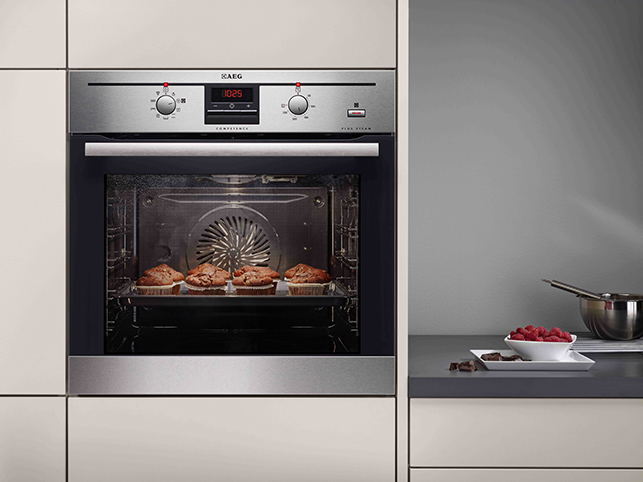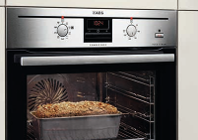
In recent years the humble kitchen oven has, like most items in our homes, taken on a more technological approach to its everyday purpose.
In a world where chefs and TV shows like The Great British Bake Off are so popular, it’s no surprise that more home cooks trying to recreate high end baking are demanding more from their cookers.
While AEG’s multifunction ovens are already its market leader, a decision was made by this home appliances brand to introduce a new feature for 2016 — steam for baking.
The AEG SteamBake range lets users pour 100ml of water into a specially hollowed base in the cooking space, that is directly heated, creating steam for the first 10 to 15 minutes of baking.
This steam settles on the bread dough causing sugars from within it to caramelise. After the steam dissipates, dry hot air results in a crisp golden crust with a soft and fluffy interior.
Cooking habits
From a design perspective, the oven is one of the most interesting pieces of equipment in the modern home.
“If you want to make a comparison, a washing machine is used the same almost everywhere in the world, but cooking habits are different country to country,” suggests Marco Bulgheroni, AEG’s VP Global R&D Food Preparation EMEA, and the man who oversaw the design and engineering of the SteamBake line.
Europe has very different cooking habits, and every recipe has different elements — more heat, time or humidity – that alter the variables within the cooking physics.
AEG uses real kitchens to test its products, but with its increasing use of CFD simulation tools, its kitchens are now cooking science labs, where the home economists that work there are engineers that understand the physics behind the recipes.
“How much water goes in, how much water comes out — we want to be able to make a correlation, because if you don’t have the data it’s difficult to compare and be repeatable,” says Bulgheroni.
“Every chef has their own recipe but for normal consumers you need to find a way to give them the chance to make great food.”
The team work with a wide range of software, from Simulia to Ansys, for CFD analysis. One of the key tasks is calculating the impact of the heat distribution, humidity and airflow around the oven cavity.
If the flow of these elements is not right then the heat distribution within the food is not the same throughout, so it has a huge impact.
“There’s nothing better for testing this than simulation, because if you try to use trial and error it takes forever,” explains Bulgheroni.
“You need to have a base of simulation and mathematical numbers behind it, and then you’re tasked with the true [physical] tests at the end of the process.”
Design process
The design process begins with a central brief developed from the marketing and trends teams, where for SteamBake the brief was simply to add a new function and update some styling elements.
The range only uses steam for the initial stages of the baking, unlike other ovens that need to have a small water tank or be plumbed in to provide longer periods of humidity — making it easier to replace an existing oven.
This relationship with the rest of the kitchen furniture is an important one; very few people have a full kitchen fitted every time they purchase a new oven.
“You don’t buy an oven like you do a pair of shoes,” explains Mina Ivanovic, AEG European Director for Ovens. “An oven generally lives inside a kitchen for 7 to 10 years, and the cabinets generally live for 15 years, sometimes up to 20, so all of that has to match.
“So when you come up with a new oven, it has to look nice and modern, but still fit the rest [of its surroundings].”
The brief is then transferred to specialist R&D engineering teams around Europe, with main tech centres based in Italy, Germany and Romania providing component development for elements such as steam, electrical, induction, gas, and microwave cooking.
The resulting technology moves to AEG’s pure product development teams in Sweden, which use CATIA to combine everything together, adding styling and user interface design, before physical prototypes are built for manual testing.
Hands-on tests with users still play a big role in determining ergonomics, usability, and gaining impressions of aesthetics, and led to the building of AEG’s new lab in Stockholm, Sweden, where consumers test the usability of products.
“They’re given a simple task like to boil a pan of water on a hob, or set the ‘pizza’ function for the oven, and we see how they operate the product, how easily they can use the handles, comments they make, the faces they make! Because we have cameras all over, if they make a [confused look] face, then you know you’ve got it wrong,” says Ivanovic.
Maintenance and repair
By continually adding more features and producing products with more complex mechanics, AEG is having to adapt its after sales care for maintenance and repair.
“Today you take your car to be serviced and they plug in a computer and it tells them exactly what is wrong,” says Bulgheroni.
“Our technicians can get out and diagnose problems with ovens, but in the future we want to do this remotely.
“The technician needs to go out anyhow, but now he goes out with the right tools and components to replace, and it can be faster and more efficient.”
For AEG this has positive implications for its future designs. While today it can’t get reliable data on how often customers bake, clean or maintain their ovens, in the future, with the right sensors, all that information can be harvested.
Designing the new AEG SteamBake oven range
Default






